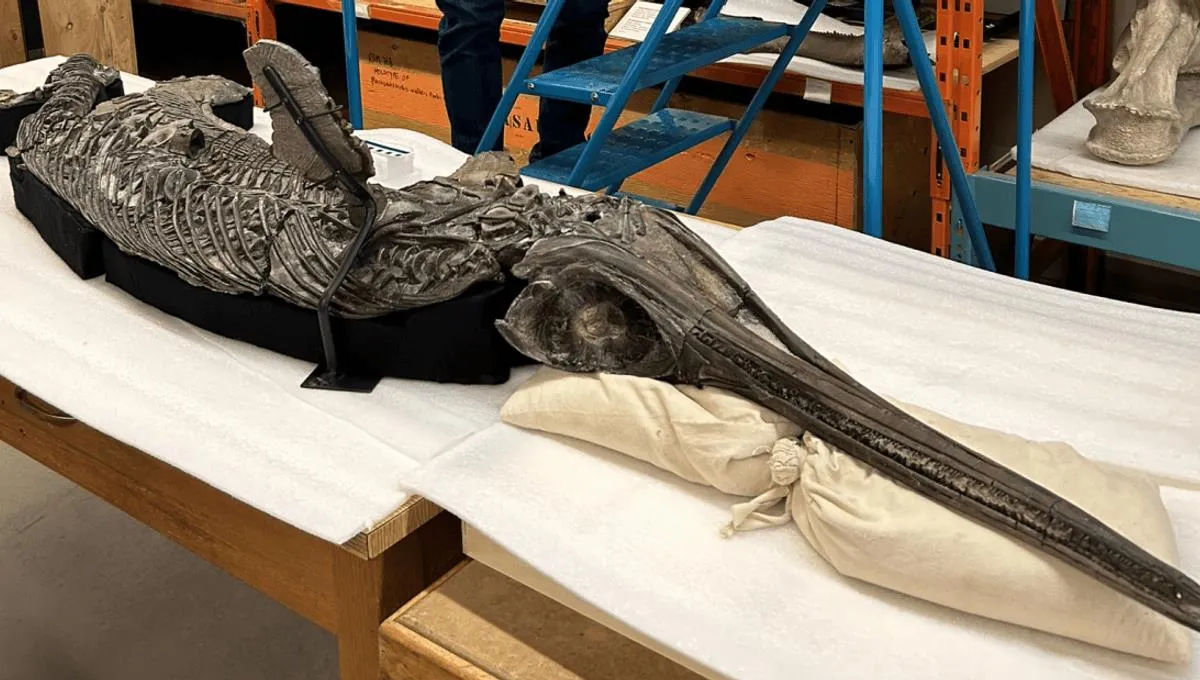
The recent discovery of a new-to-science species, an ichthyosaur nicknamed the “Sword Dragon of Dorset,” has captivated paleontologists and fossil enthusiasts alike. Officially named Xiphodracon goldencapensis, this remarkable creature is estimated to be around 3 meters (9.8 feet) long. The ichthyosaur was uncovered by fossil collector Chris Moore, who previously gained attention for his discovery of a massive pliosaur skull.
Chris Moore's journey to find the “Sword Dragon of Dorset” began when he spotted a section of tail vertebrae protruding from the ground. After covering it up and obtaining permission to excavate, he followed the vertebrae and discovered more parts of the skeleton, including the rear paddles, rib cage, front paddles, and eventually, the skull. “I hit this hard object, which turned out to be the skull, and it was preserved in three dimensions,” Moore explained. Unlike most ichthyosaurs, whose bones often become flattened and two-dimensional, this specimen remained remarkably intact.
The well-preserved skull of Xiphodracon goldencapensis features two eyes on either side and a striking, long, sword-like rostrum adorned with hundreds of tiny needle teeth. This exceptional preservation is characteristic of the region, which was once a vibrant, shallow tropical sea rich with life, including ichthyosaurs' favorite foods like ammonites, fish, and belemnites.
Additionally, the region's anoxic seabed played a crucial role in fossil preservation. When animals died, their remains sank to the bottom and were buried in poisonous mud, protecting them from disturbance. “A top tip if you want to become a fossil,” Moore noted humorously.
Moore described the discovery process as being “in the mists of time,” given the 24-year gap between the initial finding and the formal identification of the species. When asked about the unusual delay, Moore remarked, “This is exceptionally long, but in geological time, I suppose it’s nothing.” This extended timeframe highlights the importance of the specimen in filling an ichthyosaur void during a pivotal stage in their evolution.
The specimen was sent to the Royal Ontario Museum, where it came under the scrutiny of renowned ichthyologist Dr. Chris McGowan. Unfortunately, the fossil remained unexamined after McGowan's retirement, prompting Dr. Dean Lomax to investigate further. A new paper detailing the findings confirms that this ichthyosaur species is not only new to science but also incredibly rare. While many ichthyosaurs have been discovered from different time periods, few specimens from the Pliensbachian era have been found, making this discovery particularly significant.
While the original specimen is still housed in Ontario, Moore has uncovered a second specimen, affectionately dubbed “Gonzo” due to its buckled jaw, which is now on display at the Charmouth Heritage Coast Centre in Dorset, UK. This specimen provides further insight into the ichthyosaur lineage during a critical window in the Jurassic timeline, a period marked by significant changes in Earth’s fauna.
Dr. Lomax emphasizes the importance of this discovery, stating, “This new find helps to fill in somewhat of an ichthyosaur void during this pivotal stage in their evolution.” While researchers are still unraveling the causes behind the significant shifts in ichthyosaur populations, the new species offers valuable clues about their evolutionary history and adaptations.
The fossil of Xiphodracon goldencapensis boasts several unique features, possibly including preserved stomach contents, which can provide further insights into its diet and behavior. “There's a lot of cool features with this fossil,” said Lomax. “If I had to pick just a few, I'd highlight the extremely long, sword-like snout and massive eye, which are genuinely eye-catching.” Additionally, the lacrimal bone surrounding the nostril opening is described as “super weird,” showcasing a characteristic not previously observed in any ichthyosaur.
For those intrigued by unique fossil discoveries, this ichthyosaur is just one of many fascinating findings in the world of paleontology. The cover star of Lomax’s latest book, “The Secret Lives Of Dinosaurs,” features a two-headed prehistoric creature, further exemplifying the diversity and complexity of life in ancient ecosystems.